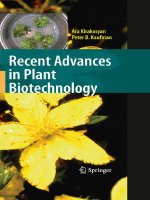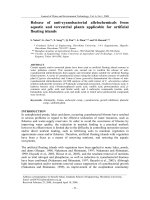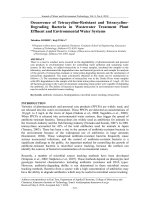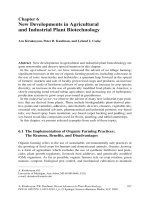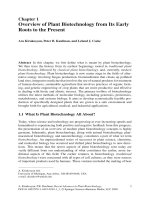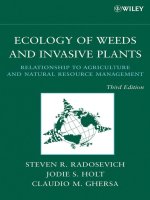plant biotechnology and transgenic plants - kirsi-marja oksman-caldentey , wolfgang h. barz
Bạn đang xem bản rút gọn của tài liệu. Xem và tải ngay bản đầy đủ của tài liệu tại đây (35.75 MB, 694 trang )
PLANT
BIOTECHNOLOGY
AND
TRANSBENIC
PLANTS
EDITED
BY
KIRSI-MARJA
OKSMAH-CALDENTEY
VTT
Technical
Research
Center
of
Finland
Espoo, Finland
WOLFGANG
H.
BARZ
Westphalian
Wilhelm's
University Munich
Munich, Germany
MARCEL
H
MARCEL
DEKKER,
INC.
NEW
YORK
•
BASEL
Copyright © 2002 Marcel Dekker, Inc.
ISBN:
0-8247-0794-X
This book
is
printed
on
acid-free paper.
Headquarters
Marcel
Dekker,
Inc.
270
Madison Avenue,
New
York,
NY
10016
tel:
212-696-9000;
fax:
212-685-4540
Eastern
Hemisphere
Distribution
Marcel Dekker
AG
Hutgasse
4,
Postfach
812,
CH-4001
Basel, Switzerland
tel:
41-61-260-6300;
fax:
41-61-260-6333
World Wide
Web
The
publisher
offers
discounts
on
this book when ordered
in
bulk quantities.
For
more information, write
to
Special
Sales/Professional
Marketing
at the
headquarters
address above.
Copyright
©
2002
by
Marcel Dekker, Inc.
All
Rights Reserved.
Neither this book
nor any
part
may be
reproduced
or
transmitted
in any
form
or by
any
means, electronic
or
mechanical,
including
photocopying, microfilming,
and
recording,
or by any
information storage
and
retrieval system, without permission
in
writing
from
the
publisher.
Current printing (last digit):
10
987654321
PRINTED
IN THE
UNITED STATES
OF
AMERICA
Copyright © 2002 Marcel Dekker, Inc.
BOOKS
IN
SOILS,
PLANTS,
AND THE
ENVIRONMENT
Editorial
Board
Agricultural
Engineering
Animal
Science
Crops
Irrigation
and
Hydrology
Microbiology
Plants
Soils
Robert
M.
Peart, University
of
Florida, Gainesville
Harold
Hafs,
Rutgers University,
New
Brunswick,
New
Jersey
Mohammad
Pessarakli,
University
of
Arizona,
Tucson
Donald
R.
Nielsen,
University
of
California, Davis
Jan
Dirk
van
Elsas,
Research Institute
for
Plant
Protection,
Wageningen,
The
Netherlands
L.
David Kuykendall, U.S. Department
of
Agriculture,
Beltsville,
Maryland
Jean-Marc
Bollag,
Pennsylvania
State
University,
University Park, Pennsylvania
Tsuyoshi
Miyazaki,
University
of
Tokyo
Soil Biochemistry,
Soil Biochemistry,
Soil Biochemistry,
Soil Biochemistry,
Soil Biochemistry,
Soil
Biochemistry,
Soil Biochemistry,
Soil Biochemistry,
Soil Biochemistry,
Soil Biochemistry,
Volume
1,
edited
by A. D.
McLaren
and G. H.
Peterson
Volume
2,
edited
by A. D.
McLaren
and J.
Skujins
Volume
3,
edited
by E. A.
Paul
and A. D.
McLaren
Volume
4,
edited
by E. A.
Paul
and A. D.
McLaren
Volume
5,
edited
by E. A.
Paul
and J. N.
Ladd
Volume
6,
edited
by
Jean-Marc Bollag
and G.
Stotzky
Volume
7,
edited
by G.
Stotzky
and
Jean-Marc Bollag
Volume
8,
edited
by
Jean-Marc Bollag
and G.
Stotzky
Volume
9,
edited
by G.
Stotzky
and
Jean-Marc Bollag
Volume
10,
edited
by
Jean-Marc Bollag
and G.
Stotzky
Organic
Chemicals
in the
Soil Environment, Volumes
1 and 2,
edited
by C.
A.
I.
Goring
and J. W.
Hamaker
Humic Substances
in the
Environment,
M.
Schnitzer
and S. U.
Khan
Microbial
Life
in the
Soil:
An
Introduction,
T.
Hattori
Principles
of
Soil Chemistry,
Kim H. Tan
Soil Analysis: Instrumental Techniques
and
Related Procedures,
edited
by
Keith
A.
Smith
Soil Reclamation Processes: Microbiological Analyses
and
Applications,
edited
by
Robert
L.
Tate
III and
Donald
A.
Klein
Symbiotic Nitrogen Fixation Technology,
edited
by
Gerald
H.
Elkan
Soil-Water
Interactions: Mechanisms
and
Applications,
Shingo
Iwata
and
Toshio
Tabuchi with Benno
P.
Warkentin
Copyright © 2002 Marcel Dekker, Inc.
So/7
Analysis: Modem Instrumental Techniques, Second Edition,
edited
by
Keith
A.
Smith
Soil
Analysis: Physical Methods,
edited
by
Keith
A.
Smith
and
Chris
E.
Mullins
Growth
and
Mineral Nutrition
of
Field Crops,
N. K.
Fageria,
V. C.
Baligar,
and
Charles Allan Jones
Semiarid
Lands
and
Deserts: Soil Resource
and
Reclamation,
edited
by J.
Skujin§
Plant Roots:
The
Hidden Half,
edited
by
Yoav
Waisel,
Amram
Eshel,
and Uzi
Kafkafi
Plant Biochemical Regulators,
edited
by
Harold
W.
Gausman
Maximizing Crop Yields,
N. K.
Fageria
Transgenic
Plants: Fundamentals
and
Applications,
edited
by
Andrew
Hiatt
Soil
Microbial Ecology: Applications
in
Agricultural
and
Environmental
Management,
edited
by F.
Blaine
Metting,
Jr.
Principles
of
Soil Chemistry: Second Edition,
Kim H. Tan
Water
Flow
in
Soils,
edited
by
Tsuyoshi
Miyazaki
Handbook
of
Plant
and
Crop Stress,
edited
by
Mohammad Pessarakli
Genetic
Improvement
of
Field Crops,
edited
by
Gustavo
A.
Slater
Agricultural Field Experiments: Design
and
Analysis,
Roger
G.
Petersen
Environmental Soil Science,
Kim H. Tan
Mechanisms
of
Plant Growth
and
Improved Productivity: Modem
Ap-
proaches,
edited
by
Amarjit
S.
Basra
Selenium
in the
Environment,
edited
by W. T.
Frankenberger, Jr.,
and
Sally
Benson
Plant-Environment Interactions,
edited
by
Robert
E.
Wilkinson
Handbook
of
Plant
and
Crop Physiology,
edited
by
Mohammad Pessarakli
Handbook
of
Phytoalexin
Metabolism
and
Action,
edited
by M.
Daniel
and R.
P.
Purkayastha
Soil-Water
Interactions: Mechanisms
and
Applications, Second Edition,
Re-
vised
and
Expanded,
Shingo
Iwata,
Toshio
Tabuchi,
and
Benno
P.
Warkentin
Stored-Grain
Ecosystems,
edited
by
Digvir
S.
Jayas, Noel
D. G.
White,
and
William
E.
Muir
Agrochemicals
from
Natural Products,
edited
by C. R. A.
Godfrey
Seed
Development
and
Germination,
edited
by
Jaime
Kigel
and Gad
Galili
Nitrogen Fertilization
in the
Environment,
edited
by
Peter Edward Bacon
Phytohormones
in
Soils: Microbial Production
and
Function,
William
T.
Frankenberger, Jr.,
and
Muhammad Arshad
Handbook
of
Weed
Management Systems,
edited
by
Albert
E.
Smith
Soil
Sampling,
Preparation,
and
Analysis,
Kim H. Tan
So/7
Erosion, Conservation,
and
Rehabilitation,
edited
by
Menachem Agassi
Plant Roots:
The
Hidden
Half,
Second Edition, Revised
and
Expanded,
edited
by
Yoav
Waisel, Amram Eshel,
and Uzi
Kafkafi
Photoassimilate
Distribution
in
Plants
and
Crops:
Source-Sink
Relation-
ships,
edited
by Eli
Zamski
and
Arthur
A.
Schaffer
Mass
Spectrometry
of
Soils,
edited
by
Thomas
W.
Boutton
and
Shinichi
Yamasaki
Copyright © 2002 Marcel Dekker, Inc.
Handbook
of
Photosynthesis,
edited
by
Mohammad
Pessarakli
Chemical
and
Isotopic
Groundwater
Hydrology:
The
Applied
Approach,
Second Edition, Revised
and
Expanded,
Emanuel
Mazor
Fauna
in
Soil Ecosystems: Recycling Processes, Nutrient Fluxes,
and
Agri-
cultural Production,
edited
by
Gero
Benckiser
Soil
and
Plant Analysis
in
Sustainable Agriculture
and
Environment,
edited
by
Teresa
Hood
and J.
Benton
Jones,
Jr.
Seeds Handbook: Biology, Production, Processing,
and
Storage,
B. B.
Desai,
P. M.
Kotecha,
and D. K.
Salunkhe
Modern
Soil Microbiology,
edited
by J. D. van
Elsas,
J. T.
Trevors,
and E. M.
H.
Wellington
Growth
and
Mineral Nutrition
of
Field Crops: Second Edition,
N. K.
Fageria,
V.
C.
Baligar,
and
Charles
Allan
Jones
Fungal Pathogenesis
in
Plants
and
Crops: Molecular
Biology
and
Host
Defense Mechanisms,
P.
Vidhyasekaran
Plant Pathogen Detection
and
Disease Diagnosis,
P.
Narayanasamy
Agricultural Systems Modeling
and
Simulation,
edited
by
Robert
M.
Peart
and R.
Bruce
Curry
Agricultural Biotechnology,
edited
by
Arie
Altman
Plant-Microbe Interactions
and
Biological Control,
edited
by
Greg
J.
Boland
and
L.
David
Kuykendall
Handbook
of
Soil Conditioners: Substances
That
Enhance
the
Physical
Properties
of
Soil,
edited
by
Arthur
Wallace
and
Richard
E.
Terry
Environmental Chemistry
of
Selenium,
edited
by
William
T.
Frankenberger,
Jr.,
and
Richard
A.
Engberg
Principles
of
Soil Chemistry:
Third
Edition, Revised
and
Expanded,
Kim H.
Tan
Sulfur
in the
Environment,
edited
by
Douglas
G.
Maynard
Soil-Machine Interactions:
A
Finite Element
Perspective,
edited
by Jie
Shen
and
Radhey
Lai
Kushwaha
Mycotoxins
in
Agriculture
and
Food
Safety,
edited
by
Kaushal
K.
Sinha
and
Deepak
Bhatnagar
Plant
Amino
Acids: Biochemistry
and
Biotechnology,
edited
by
Bijay
K.
Singh
Handbook
of
Functional
Plant Ecology,
edited
by
Francisco
I.
Pugnaire
and
Fernando
Valladares
Handbook
of
Plant
and
Crop
Stress: Second Edition, Revised
and Ex-
panded,
edited
by
Mohammad
Pessarakli
Plant Responses
to
Environmental Stresses:
From
Phytohormones
to Ge-
nome Reorganization,
edited
by H. R.
Lerner
Handbook
of
Pest Management,
edited
by
John
R.
Ruberson
Environmental Soil Science: Second Edition, Revised
and
Expanded,
Kim H.
Tan
Microbial
Endophytes,
edited
by
Charles
W.
Bacon
and
James
F.
White,
Jr.
Plant-Environment Interactions: Second Edition,
edited
by
Robert
E.
Wil-
kinson
Microbial Pest Control,
Sushil
K.
Khetan
Soil
and
Environmental Analysis: Physical Methods, Second Edition,
Re-
vised
and
Expanded,
edited
by
Keith
A.
Smith
and
Chris
E.
Mullins
Copyright © 2002 Marcel Dekker, Inc.
The
Rhizosphere:
Biochemistry
and
Organic Substances
at the
Soil-Plant
Interface,
Roberto Pinton, Zeno
Varanini,
and
Paolo
Nannipieri
Woody
Plants
and
Woody
Plant Management: Ecology,
Safety,
and
Envi-
ronmental Impact,
Rodney
W.
Bovey
Metals
in the
Environment: Analysis
by
Biodiversity,
M. N. V.
Prasad
Plant Pathogen Detection
and
Disease Diagnosis: Second Edition, Revised
and
Expanded,
P.
Narayanasamy
Handbook
of
Plant
and
Crop Physiology: Second Edition, Revised
and
Expanded,
edited
by
Mohammad Pessarakli
Environmental Chemistry
of
Arsenic,
edited
by
William
T.
Frankenberger,
Jr.
Enzymes
in the
Environment: Activity, Ecology,
and
Applications,
edited
by
Richard
G.
Bums
and
Richard
P.
Dick
Plant Roots:
The
Hidden
Half,
Third
Edition, Revised
and
Expanded,
edited
by
Yoav
Wai
set,
Amram
Eshel,
and Uzi
Kafkafi
Handbook
of
Plant
Growth:
pH as the
Master
Variable,
edited
by
Zdenko
Rengel
Biological Control
of
Crop
Diseases,
edited
by
Samuel
S.
Gnanamanickam
Pesticides
in
Agriculture
and the
Environment,
edited
by
Willis
B.
Wheeler
Mathematical Models
of
Crop Growth
and
Yield,
Allen
R.
Overman
and
Richard
V.
Scholtz
III
Plant Biotechnology
and
Transgenic
Plants,
edited
by
Kirsi-Marja
Oksman-
Caldentey
and
Wolfgang
H.
Barz
Additional
Volumes
in
Preparation
Handbook
of
Postharvest
Technology,
edited
by A.
Chakraverty,
Arun
S.
Mujumdar,
G. S. V.
Raghavan,
and H. S.
Ramaswamy
Handbook
of
Soil Acidity,
edited
by
Zdenko Rengel
Copyright © 2002 Marcel Dekker, Inc.
Preface
Biotechnology
has
become
one of the
most promising branches
of
science
in
recent years. Plant biotechnology
is a
rapidly developing
field of
plant
research,
and
genetic engineering
is an
important tool
in
biotechnology. Bio-
technology
can
provide, among other
benefits,
more nutritious
and
safer
foods,
better agronomical traits,
and
more
effective
pharmaceuticals
or
chemicals. Medicinal plants
as
well
as
other
useful
crops have great value
for
both
the
nonfood
and the
food
industries. Plants
can be
used
as
such,
or
important metabolites
can be
isolated
from
them. Besides primary metabo-
lites, plants produce drugs, pesticides, dyes,
flavors, and
fragrances.
Plant
breeding using either conventional
or
modern breeding methods
has im-
proved
the
quality
or the
agricultural properties
of
many crop plants.
Metabolic engineering
of
plants
has
shown
its
potential both
in
basic
research
and as a
tool
of
modern plant breeding. Designer crops
can
already
produce valuable enzymes, proteins,
and
antibodies.
In
many research lab-
oratories
and
companies
in
Europe,
the
United States,
and
Japan, much work
has
been done
in
studying secondary metabolic pathways
by
isolating spe-
cific
genes that regulate
the
function
of
some
key
enzymes.
The
output
of
this
type
of
research
has
been tremendous
due to the
rapid development
of
plant
molecular biology techniques. Furthermore,
the
large-scale production
of
useful
plant material
or
metabolites
in
bioreactors shows
new
possibilities
in
plant
biotechnology.
We
intend
in
this book
to
provide
the
most up-to-date information
on
plant biotechnology
and
transgenic plant production.
We
review available
methodologies
for
plant cell culture, transformation techniques
for
crop
im-
Copyright © 2002 Marcel Dekker, Inc.
provement,
and
strategies
to
yield
high-value
products.
In
addition,
a
wide
spectrum
of
various applications
of
genetically engineered plants
is
pre-
sented. These activities
are
demonstrated
in
almost
30
chapters written
by
the
most outstanding scientists
in
their respective
field. We
have kept
in
mind
a
broad range
of
readers
in
both academia
and
industry.
We
hope
that
this book also
will
be of
interest
to
students
of
plant biology
and
biotech-
nology
as
well
as to
more experienced scientists
who
produce transgenic
plants.
Kirsi-Marja
Oksman-Caldentey
Wolfgang
H.
Barz
Copyright © 2002 Marcel Dekker, Inc.
Contents
Preface
Contributors
1.
Plant
Biotechnology—An
Emerging
Field
Wolfgang
H.
Barz
and
Kirsi-Marja
Oksman-Caldentey
2.
Plant-Derived Drugs
and
Extracts
Yvonne
Holm
and
Raimo Hiltunen
3.
Industrial Strategies
for the
Discovery
of
Bioactive
Compounds
from
Plants
Helmut
Kessmann
and
Bernhard Schnurr
4.
Plant Cell
and
Tissue Culture Techniques Used
in
Plant Breeding
Peter
M. A.
Tigerstedt
and
Anna-Maija
Niskanen
5.
Plant Cell Cultures
as
Producers
of
Secondary Compounds
Kazuki
Saito
and
Hajime
Mizukami
6.
Genetic Transformation
of
Plants
and
Their Cells
Richard
M.
Twyman,
Paul Christou,
and Eva
Stoger
7.
Properties
and
Applications
of
Hairy Root Cultures
Pauline
M.
Doran
8.
Bioreactors
for
Plant Cell
and
Tissue Cultures
Regine
Eibl
and
Dieter
Eibl
Copyright © 2002 Marcel Dekker, Inc.
9. The
Potential Contribution
of
Plant Biotechnology
to
Improving
Food
Quality
D. G.
Lindsay
10.
Engineering Plant Biochemical Pathways
for
Improved
Nutritional
Quality
Michel Jacobs, Marc
Vauterin,
Eric
Dewaele,
and
Adrian
Craciun
11.
Transgenic Plants
as
Producers
of
Modified Starch
and
Other Carbohydrates
A
Ian
H.
Schulman
12.
Improving
the
Nutritional Quality
and
Functional
Properties
of
Seed
Proteins
by
Genetic Engineering
Peter
R.
Shewry
13.
Transgenic Plants
as
Sources
of
Modified Oils
Sean
J.
Coughlan
and
Anthony
J.
Kinney
14.
Flavors
and
Fragrances
from
Plants
Holger Zorn
and
Ralf
G.
Berger
15.
Fine Chemicals
from
Plants
Michael
Keil
16.
Genetic Engineering
of the
Plant
Cell
Factory
for
Secondary
Metabolite Production: Indole Alkaloid Production
in
Catharanthus
roseus
as a
Model
Serap
Whitmer,
Robert
van der
Heijden,
and
Robert
Verpoorte
17.
Transgenic Plants
for
Production
of
Immunotherapeutic
Agents
James
W.
Larrick,
Lloyd
Yu,
Sudhir
Jaiswal,
and
Keith
Wycoff
18.
Signal Transduction Elements
Dierk
Scheel
19.
The
Plant Cell
Wall—Structural
Aspects
and
Biotechnological Developments
Bruno
Moerschbacher
20.
Lignin Genetic Engineering:
A Way to
Better Understand
Lignification
beyond Applied Objectives
Alain-M.
Boudet
Copyright © 2002 Marcel Dekker, Inc.
21.
Transgenic Plants Expressing Tolerance Toward
Oxidative Stress
Frank
Van
Breusegem
and
Dirk
Inze
22.
Transgenic Plants with Increased Tolerance against
Viral
Pathogens
Holger
Jeske
23.
Transgenic Plants with Enhanced Tolerance against
Microbial Pathogens
Raimund
Tenhaken
24.
Transgenic Crop Plants with Increased Tolerance
to
Insect Pests
Danny
J.
Llewellyn
and
Thomas
J. V.
Higgins
25.
Transgenic Herbicide-Resistant
Crops—Advantages,
Drawbacks,
and
Failsafes
Jonathan
Gressel
26.
Plants
and
Environmental Stress Adaptation Strategies
Hans
J.
Bohnert
and
John
C.
Cushman
27.
Molecular Mechanisms that Control Plant Tolerance
to
Heavy Metals
and
Possible Roles
in
Manipulating
Metal Accumulation
Stephan
Clemens,
Sebastien
Thomine,
and
Julian
I.
Schroeder
Copyright © 2002 Marcel Dekker, Inc.
Contributors
Wolfgang
H.
Barz Institute
of
Plant Biochemistry
and
Biotechnology,
Westphalian
Wilhelm's University Munich, Munich, Germany
Ralf
G.
Berger Institute
of
Biochemistry, University
of
Hannover,
Hannover, Germany
Hans
J.
Bohnert
Department
of
Plant Biology, University
of
Illinois,
Urbana, Illinois, U.S.A.
Alain-M.
Boudet Institute
of
Plant Biotechnology,
UMR
CNRS/UPS
5546,
Castanet-Tolosan, France
Paul
Christou
Molecular Biology Unit, John
Innes
Centre, Norwich,
United
Kingdom
Stephan Clemens Leibniz Institute
of
Plant Biochemistry, Halle
(Saale),
Germany
Sean
J.
Coughlan
DuPont Nutrition
and
Health, Wilmington, Delaware,
U.S.A.
Adrian
Craciun
Department
of
Biotechnology, University
of
Brussels,
Sint-Genesius-Rode, Belgium
John
C.
Cushman
Department
of
Biochemistry, University
of
Nevada,
Reno, Nevada, U.S.A.
Eric
Dewaele
Department
of
Biotechnology, University
of
Brussels,
Sint-Genesius-Rode, Belgium
Copyright © 2002 Marcel Dekker, Inc.
Pauline
M.
Doran
Department
of
Biotechnology, University
of New
South Wales, Sydney, Australia
Dieter
Eibl
Department
of
Biochemistry, University
of
Applied Sciences
Wadenswil, Wadenswil, Switzerland
Regine
Eibl Department
of
Biochemistry, University
of
Applied
Sciences Wadenswil, Wadenswil, Switzerland
Jonathan
Gressel
Department
of
Plant
Sciences,
Weizmann Institute
of
Science,
Rehovot,
Israel
Thomas
J. V.
Higgins
CSIRO
Plant Industry, Canberra, Australia
Raimo
Hiltunen
Department
of
Pharmacy, University
of
Helsinki,
Helsinki, Finland
Yvonne
Holm
Department
of
Pharmacy, University
of
Helsinki,
Helsinki, Finland
Dirk
Inze
Department
of
Plant Systems Biology, Flanders Interuniversity
Institute
for
Biotechnology, Ghent University, Ghent, Belgium
Michel
Jacobs
Department
of
Biotechnology, University
of
Brussels,
Sint-Genesius-Rode, Belgium
Sudhir
Jaiswal
Planet Biotechnology Inc.,
Hay
ward,
and
Palo Alto
Institute
of
Molecular Medicine, Mountain View, California, U.S.A.
Holger
Jeske
Department
of
Molecular Biology
and
Plant Virology,
University
of
Stuttgart, Stuttgart, Germany
Michael
Keil
Boehringer Ingelheim Pharma
KG,
Ingelheim, Germany
Helmut
Kessmann*
Discovery Partners International
AG,
Allschwil,
Switzerland
Anthony
J.
Kinney DuPont Nutrition
and
Health, Wilmington,
Delaware, U.S.A.
James
W.
Larrick Planet Biotechnology Inc., Hayward,
and
Palo Alto
Institute
of
Molecular Medicine, Mountain View, California, U.S.A.
D. G.
Lindsay
Institute
of
Food Research, Norwich, United Kingdom
Danny
J.
Llewellyn CSIRO Plant Industry, Canberra, Australia
Hajime
Mizukami
Faculty
of
Pharmaceutical
Sciences,
Nagoya City
University,
Nagoya, Japan
*Current
affiliation:
Graffinity
Pharmaceuticals
AG,
Heidelberg, Germany.
Copyright © 2002 Marcel Dekker, Inc.
Bruno
M.
Moerschbacher
Institute
of
Plant Biochemistry
and
Biotechnology, Westphalian
Wilhelm's
University Munich, Munich,
Germany
Anna-Maija
Niskanen
Department
of
Applied Biology, University
of
Helsinki, Helsinki, Finland
Kirsi-Marja Oksman-Caldentey
VTT
Biotechnology,
VTT
Technical
Research Center
of
Finland, Espoo, Finland
Kazuki Saito Research Center
of
Medicinal Resources, Graduate School
of
Pharmaceutical Sciences, Chiba University, Chiba, Japan
Dierk
Scheel
Department
of
Stress
and
Developmental Biology, Institute
of
Plant Biochemistry, Halle
(Saale),
Germany
Bernhard
Schnurr
Discovery Partners International
AG,
Allschwil,
Switzerland
Julian
I.
Schroeder
Division
of
Biology, University
of
California,
San
Diego,
La
Jolla,
California, U.S.A.
Alan
H.
Schulman
Institute
of
Biotechnology, University
of
Helsinki,
and
MTT
Research Finland, Helsinki, Finland
Peter
R.
Shewry
lACR-Long
Ashton Research Station, Bristol, United
Kingdom
Eva
Stoger
Molecular Biology Unit, John
Innes
Centre, Norwich,
United Kingdom
Raimund Tenhaken Department
of
Plant Physiology, University
of
Kaiserslautern,
Kaiserslautern,
Germany
Sebastien
Thomine
Institute
of
Plant
Sciences-CNRS,
Gif-sur-Yvette,
France
Peter
M. A.
Tigerstedt
Department
of
Applied Biology, University
of
Helsinki, Helsinki, Finland
Richard
M.
Twyman
Molecular Biology Unit, John Innes Centre,
Norwich, United Kingdom
Frank
Van
Breusegem
Department
of
Plant Systems Biology, Flanders
Interuniversity
Institute
for
Biotechnology, Ghent University, Ghent,
Belgium
Robert
van der
Heijden
Leiden/Amsterdam
Center
of
Drug Research,
Leiden,
The
Netherlands
Copyright © 2002 Marcel Dekker, Inc.
Marc
Vauterin
Department
of
Biology, University
of
Brussels, Sint-
Genesius-Rode,
Belgium
Robert Verpoorte
Leiden/Amsterdam
Center
of
Drug Research, Leiden,
The
Netherlands
Scrap
Whitmer
Leiden/Amsterdam
Center
of
Drug Research, Leiden,
The
Netherlands
Keith
Wycoff Planet
Biotechnology
Inc.,
Hay
ward,
and
Palo
Alto
Institute
of
Molecular Medicine, Mountain View, California, U.S.A.
Lloyd
Yu
Planet Biotechnology Inc.,
Hay
ward,
and
Palo Alto Institute
of
Molecular Medicine, Mountain View, California, U.S.A.
Holger
Zorn
Institute
of
Biochemistry, University
of
Hannover,
Hannover,
Germany
Copyright © 2002 Marcel Dekker, Inc.
1
Plant
Biotechnology—An
Emerging Field
Wolfgang
H.
Barz
Institute
of
Plant
Biochemistry
and
Biotechnology,
Westphalian
Wilhelm's
University
Munich,
Munich,
Germany
Kirsi-Marja
Oksman-Caldentey
VTT
Biotechnology,
VTT
Technical
Research
Center
of
Finland,
Espoo,
Finland
I.
INTRODUCTION
Biotechnology
is a
scientific
discipline with
focus
on the
exploitation
of
metabolic properties
of
living organisms
for the
production
of
valuable prod-
ucts
of a
very different structural
and
organizational level
for the
benefit
of
men.
The
products
can be the
organisms themselves (i.e.,
biomass
or
parts
of
the
organismic body), products
of
cellular
or
organismic metabolism (i.e.,
enzymes,
metabolites),
or
products formed
from
endogenous
or
exogenous
substrates
with
the
help
of
single enzymes
or
complex metabolic routes.
The
organisms under question vary
from
microbes (bacteria,
fungi)
to
animals
and
plants.
In
addition
to
intact organisms, isolated cells
or
enzyme prepa-
rations
are
employed
in
biotechnology.
The
possibility
to
submit
the
pro-
ducing
organisms
or the
cellular systems
to
technical
and
even industrial
procedures
has led to
highly productive processes.
The
products
of
biotech-
nology
are of
importance
for
medicine, pharmaceutical sciences, agriculture,
food
production, chemistry,
and
numerous other disciplines.
Biotechnology receives
the
necessary
scientific
and
technical
infor-
mation
from
a
considerable number
of
disciplines. Cell biology, morphology
of
the
employed organisms, biochemistry, physiology, genetics,
and
various
Copyright © 2002 Marcel Dekker, Inc.
technical
fields are
major
sources.
In the
last
two
decades,
molecular
biology
and
gene technology have substantially contributed
to the
spectrum
of
sci-
entific
disciplines forming biotechnology.
As is
always true
for
progress
in
natural sciences,
it is
especially true
for
biotechnology that more rapid
de-
velopment
and
gain
of
higher standards depend
on the
improvement
of
methods.
In
the
historical development
of
biotechnology, microbes have been
used preferentially. They still
offer
an
extremely rich potential
for
bio-
technological application. Animal systems
and
their cells
are
also valuable
systems, especially
in
view
of the
very costly products (i.e., antibodies,
vaccines). Although much later
in the
chronological process, plant biotech-
nology
has
made
an
impressive development
in
gaining basic
and
applicable
knowledge
as
well
as in
establishing production processes.
It is
therefore
justified
to
speak
of an
emerging
field.
Major
steps will
be
discussed
in
this
chapter.
II. A
LONG HISTORY
TO
REACH
A
HIGH
STANDARD
In
each ecosystem plants
and
other photosynthetically active organisms
are
responsible
for
primary production, which provides
the
energetic
and
nutri-
tional basis
for all
subsequent trophic levels.
The
extremely high ability
of
plants
to
adapt
to all
kinds
of
environmental conditions
and
ecosystems
has
led to an
extremely wide
and
differentiated spectrum
of
plants. Since ancient
times higher plants have formed
the
main source
of
food
for
men,
and
therefore, concomitant with early phases
of
settlements
and
agriculture,
men
started
to
establish
and
improve crop plants. Archeological evidence
has
clearly shown
how
long well-known crop species (i.e., maize, cereals, leg-
umes) have been grown,
modified
by
selection,
and
thus improved
in
quality
and
yield. Plant breeding
is
indeed
an old art
that
has
been continuously
developed
in
efficiency
and
scope. Quite
typical
for
quality
breeding
of, for
instance,
cereals
is the
long
procedure
required
(sometimes
decades)
to
reach
particular genotypes
and to
cross
in
specific
genes
or
traits.
An
interesting achievement
in
breeding
of
wheat
is
characterized
by
the
term green revolution,
in
which (around
1950-1960)
wheat genotypes
from
many
different
countries were used successfully
on a
very large scale
to
breed high-yielding
and
durable lines.
For
many countries such
new va-
rieties
were
a
very great improvement
for
their agriculture.
Another important goal
in
breeding improved crop plants
is the
often
achieved adaptation
to
unfavorable environmental conditions (i.e., heat,
drought, salt,
and
other cues). Although good results have been obtained,
such
efforts
will
undoubtedly remain
in the
focus
of
future
efforts.
Better
insight
into
the
physiology,
biochemistry,
and
chemical reactions
as
well
as
Copyright © 2002 Marcel Dekker, Inc.
Plant
Biotechnology—An
Emerging Field
3
the
gene regulation
of the
endogenous adaptation
and
defense mechanisms
that
plants
can
express will contribute
to
these objectives. Gene technology
will
be an
essential component
in
these
efforts.
Another characteristic
feature
of the
long-term breeding
of
cereals,
potatoes,
or
vegetables
is the
fact
that during
the
long periods
the
shape
and
the
outer appearance
of the
plants have changed
so
much that
the
original
wild
types were either lost
or no
longer easily
identified
as
starting material.
A
typical example
is
corn. Modern agricultural crop plants
are
also bred
for
very
uniform
physical appearance, time
of flowering, and
maturity
so
that
harvest
by
machines
in an
industrial manner
is
possible (examples
are
cotton,
maize,
and
cereals).
It is a
feature
of our
high-yielding agriculture that
all
possible
mechanical techniques
are
being employed.
Very
precious treasures
for
future
agriculture
and for
plant biotech-
nology
are the
gene banks
and the
International Breeding Centers, where
great numbers
of
genotypes
of
crop plants
are
multiplied
and
carefully
pre-
served
for
long periods
of
time. Such
"pools
of
genes"
represent
the
basis
for
sustainable development
and
allow
future
programs
for
improved
ad-
aptation
of
plants
to
human needs. Fortunately,
the
understanding
has
gained
ground
in
recent years that
in
addition
to
crop plants
all
types
of
wild plants,
in
every ecosystem, must
be
preserved because
of the
genetic resources
to
be
possibly exploited
in the
future.
An
interesting development
in
itself, with
a
long history
and
remark-
able contributions
to
culture
and
art,
is the
numerous
and
sometimes highly
sophisticated ornamental plants produced
in
many countries. Beauty
of
color
and
flower
shape were
the
guidelines
in
their breeding
and
selection. Rather
early
in
this development
the
value
of
mutagenetic reagents
was
learned,
and
these
ornamentals also served
to
shape
the
term
of a
mutant. Recent
biochemical studies with,
for
example, snapdragon, tulip, chrysanthemum,
or
petunia
and
their
flavonoid
constituents clearly presented evidence that
the
various
flower
colors
can
contribute
to
identifing
biosynthetic pathways.
In
connection
with
flower
pigments, which
are
secondary metabolites,
it
should
be
remembered that numerous other secondary constitutents
of
very
different
chemical structures
are
valuable Pharmaceuticals.
In
many coun-
tries knowledge
of
plants
as
sources
of
drugs
has
been cherished
for
long
times. Modern pharmacological
and
chemical studies have helped
in the
identification
of the
relevant compounds. Such investigations
are
still con-
sidered
important objectives
of
plant biotechnology.
In
some cases extensive
breeding
programs
have
already
achieved
the
selection
and
mass
cultivation
of
high-yielding lines.
In
modern pharmacy, about
25% of
drugs still contain
active compounds
from
natural sources, which
are
primarily isolated
from
plants.
Copyright © 2002 Marcel Dekker, Inc.
4
Barz
and
Oksman-Caldentey
For a
good number
of
years
in the
period from 1950
to
1980, plant
biochemistry
and
plant biophysics concentrated
on
elucidation
of the
pho-
tosynthetic
processes.
The
pathways
of
CO
2
assimilation
as
well
as
structure,
energy transfer reactions,
and
membrane organization
of
chloroplasts
and
their thylakoids were objectives
of
primary interest. Chloroplast organization
and
molecular
function
of
this organelle
can be
regarded
as
well-understood
fields
in
plant biochemistry
and
physiology.
The
last three decades
of the
20th century were characterized
by
very
comprehensive molecular analyses
of
chemical reactions,
metabolic
path-
ways,
cellular organization,
and
adaptative responses
to
unfavorable envi-
ronmental conditions
in
numerous plant systems.
A
very broad
set of
data
has
been accumulated
so
that plant biochemistry
and
closely related
fields
can now
offer
a
good understanding
of
plants
as
multicellular organisms
and
highly adaptative systems.
From
a
molecular point
of
view,
the
construction
and the
functioning
of the
different
tissues
and
organs have
become
clear.
Numerous experimental techniques have contributed
to
this development
and
some
are
typical plant-specific methods (i.e., cell culture techniques) with
a
very
broad
scope
of
application.
A
fascinating
field of
modern plant biochemistry concerns
the
eluci-
dation
of the
function
and the
molecular mechanisms
of the
various
photo-
receptor systems
of
higher plants. Red/far
red
receptors, blue
light-absorb-
ing
cryptochromes,
and
ultraviolet (UV) light photoreceptors
are
essential
components
of
plant development
(1).
These
systems translate
a
light signal
into
physiological responses
via
gene activation. Quite remarkable, phos-
phorylated/unphosphorylated
proteins
are the
essential components
of the
signal
transduction system (1,2). Biotechnology will gain
from
this knowl-
edge,
and
highly sensitive sensor systems could possibly
be
constructed.
In
the
history
of
plant sciences
and
biotechnology,
the
recent devel-
opment
of
molecular biology
and the
introduction
of
gene technology
de-
serve emphasis. Isolation, characterization,
and
functional determination
of
genes have
become
possible. Many plant genes were rather rapidly identi-
fied,
and
the
number
is
increasing
at
enormous speed. Promoter analyses
and
identification
of
promoter binding proteins have decisively contributed
to an
understanding
of the
organization
and
function
of
plants
as
organisms
consisting
of
multiple tissues
and
different
organs.
The
phenomena
of
mul-
tigenes
and
multiple enzymes
in one
protein family were
further
revealed.
Many
different
techniques
in
molecular biology
and
gene technology turned
out
to be
extremely valuable. Recognition
of the
biology
of
Agrobacterium
tumefaciens
and
application
of its
transferred
DNA
(T-DNA) system
repre-
sented giant leaps forward.
In
general, because
of
these modern gene tech-
nological
methods, plant biotechnology
has
grown into
a new
dimension
with
putative
future
possibilities that
can
hardly
be
overestimated.
Copyright © 2002 Marcel Dekker, Inc.
Plant
Biotechnology—An
Emerging
Field
5
In
the
following sections
of
this chapter several recent
and
future
as-
pects
of
biotechnological relevance will
be
discussed.
III. PLANT
TISSUE
AND
CELL
CULTURES—A
VERY
VERSATILE
SYSTEM
The
present status
of
plant biotechnology cannot
be
evaluated without
ap-
preciation
of the
many possibilities
and the
potential
of
organ, tissue
and
cell suspension cultures. Plants
of
wide taxonomic origin have been sub-
jected
to
culture under strictly aseptic conditions. Completely chemically
defined
media
supplemented
with growth regulators
and
phytohormones
are
the
basis
for the
exploitation
of
this technique. Depending
on the
explant
and
the
culture conditions cells either preserve their state
of
biochemical
and
morphological differentiation
or
return
to a
status
of
embryogenic,
un-
differentiated
cells.
The
former situation
can be
used
for
organ cultures (e.g.,
pollen, anthers,
flower
buds, roots), whereas
the
latter leads
to
many callus
and
suspension types
of
cultures (3).
For
example,
the
cell culture technique
has
opened
a
facile route
to
haploid cells
and
plants,
and
such systems
are
of
great importance
for
genetic
and
breeding studies.
Whenever
a
heterogeneous group
of
cells
can be
turned into
a
state
of
practically uniform
cells,
this much less complicated cellular system
can
then
be
exploited
to
study many problems. This
has
been performed with
plant cell cultures
for
some
30
years now. Growth
of
cells
in
medium-size
and
large volumes
has
opened interesting applications
for
plant biotechnol-
ogy.
Numerous physiological, biochemical, genetic,
and
morphological
re-
sults
and
data
on
cellular regulation stem
from
such investigations.
Various
primary
and
secondary metabolic routes have been elucidated with
the
help
of
cell
culture systems.
The
typical sequence
in
pathway identification
was
first
product
and
intermediate characterization, then enzyme studies,
and
finally
isolation
of
genes. Furthermore, application
of
gene technology
in
the field of
transgenic plants depends
to
some extent
on the
tissue
and
cell
culture
techniques (4).
Plants
are
characterized
by
totipotency,
which means that each cell
possesses
and can
express
the
total genetic potential
to
form
a
fully
fertile
and
complete plant body. This
fact,
highly remarkable
from
a
cell biological
point
of
view,
is the
genetic basis
for
important
and
widely used applications
of
the
cell culture technique. Differentiation
of
single cells
or
small aggre-
gates
of
cells
into embryos, tissues,
and
even plants allows
the
selection
of
interesting genotypes
for
several
different
fields of
plant application (5).
The
well-established procedures
for
mass regeneration
of
valuable
specimens
of
ornamental
and
crop plants constitute
an
important business
section
in
agriculture
and
gardening. Endangered plant species
can be
saved
Copyright © 2002 Marcel Dekker, Inc.
6
Barz
and
Oksman-Caldentey
from
extinction
so
that valuable
gene
pools
will
not
disappear.
Remark-
able progress
has
been achieved
in
mass regeneration
of
trees
from
single
plants
or
tissue pieces. This will undoubtedly
be of
further
great
benefit
for
forestry
because several problems
in
tree multiplication
can
thus
be
circum-
vented (6).
Furthermore,
it
should
be
mentioned that plant cell suspension cultures
possess
a
great potential
for
biotransformation
reactions
in
which exoge-
nously
applied substrates
are
converted
in
sometimes high yields. Position
and
stereospecific
hydroxylations, oxidations, reductions,
and
especially
in-
teresting glucosylation
of
very
different
substrates have been
found
(7).
The
plant cell culture technique
has
allowed
the
facile isolation
of
mutants
from
many
plant species.
The
overwhelming importance
of
mutants
for
biochem-
ical
and
genetic studies
has
been known
for
decades. Over
the
years,
mu-
tations
from
all
areas
of
cellular metabolism have been
selected
and
char-
acterized.
A
good deal
of our
basic knowledge
of the
functioning
and
regulation
of
organisms
and
cells
and
their
organelles
stems from work with
mutants.
The
various techniques
of
plated, suspended,
or
feeder
cell-sup-
ported cell systems
and
even protoplasts have
found
wide applications (5).
The
normal rate
of
mutation
and
also increased levels
of
mutated cells
in-
duced
by
physical
(UV
light, high-energy irradiation)
or
chemical mutagens
(many
such compounds
are
known) have been used.
The
specific
advantage
of
cell cultures
for
mutant selection
is the
possible isolation
of
single cells
from
a
mass
of
unmutated ones. Heterotrophic, photomixotrophic,
and
pho-
toautotrophic cells
are
available,
and
thus
different
areas
of
cell metabolism
can be
screened
for
mutations.
In
the
cell culture
field,
regulatory mutants (i.e., excessive accumula-
tion
of
products
of
primary
and
secondary metabolism including visible
pigments), uptake mutants (i.e.,
the
normal cellular transport systems
of
nutrients into cells
are
invalidated),
and
resistance mutants (i.e., pronounced
cellular tolerance against toxic compounds such
as
mycotoxins, pesticides,
amino
acid
analogues,
or
salt) have
especially
been
characterized.
Various
auxotrophic
mutants
in the field of
growth regulators have also been
of
considerable value (3).
As
an
example,
a
series
of
studies using
photoautotrophic
cell suspen-
sion cultures
and the
highly toxic herbicide metribuzin blocking electron
transport
in
photosystem
II
will
be
cited (8,9).
A
series
of
single, double,
or
even triple mutants
of the
Dl
protein coded
by the
chloroplast psbA gene
were selected
and
thoroughly characterized.
The
various lines allowed
in-
teresting
insights into
the
mechanism
of
herbicide interference with
the Dl
protein.
In
a
discussion
of
plant mutants resistant
to
herbicides,
the
impressive
results
on
herbicide-resistant crop plants require mention. Many
of the
mech-
Copyright © 2002 Marcel Dekker, Inc.
Plant
Biotechnology—An
Emerging Field
7
anistic
and
metabolic
aspects
of
herbicide
resistance
were
first
elucidated
with
cell cultures
(10).
Modern plant biotechnology
has a
wide choice
of
biochemical solutions
for
herbicide resistance
by
inactivation
and
detoxifi-
cation reactions. Several
major
crop plant species
(i.e.,
soybean, cotton,
maize, rape)
are
presently cultivated
to a
large extent
in the
form
of
appro-
priately manipulated genotypes. This development
is on the one
hand
re-
garded
as a
major
advantage
for
agriculture
but on the
other hand
as a
subject
of
extensive
and
often
very critical public debate.
IV.
FROM GENES
TO
PATHWAYS
TO
BIOTECHNOLOGICAL
APPLICATION
A
landmark
in our
understanding
of the
structure,
the
organization,
and the
functioning
of
multicellular
organisms
is
described
by the
extensive
eukar-
yotic genome sequencing projects
in the
last decade.
The
genomes
of the
yeast
Saccharomyces
cerevisiae,
the
nematode
Caenorhabditis
elegans,
and
the
fruit
fly
Drosophila melanogaster clearly revealed
the
genetic basis
of
the
similarities
and the
differences
of
diverse multicellular organisms
(11).
This
modest
number should perhaps
be
compared with
the 56
completed
prokaryotic
genome sequences
(10
strains
of
archaea
and 46 of
bacteria)
and
the
more than
200 in
progress.
In
general,
the
number
of
genome sequencing
projects
is
increasing rapidly.
The
three
eukaryotic
genomes have
a
similar
set of
10,000-15,000
different
proteins, suggesting that this
is the
minimal complexity required
by
extremely diverse
eukaryotes
to
execute development, essential metabolic
pathways,
and
adequate responses
to
their environment. These available
eu-
karyotic genome sequences thus also document basic lines
of
organismic
evolution.
The
recent completion
and
publication
of the first
complete genome
sequence
of a flowering
plant,
the
brassica Arabidopsis
thaliana,
represents
a
further
giant step
forward
(12).
The
genome
of
this model plant, dispersed
over
five
chromosomes, documents
for
plant scientists
a
complete
set of
genes controlling developmental
and
growth patterns, primary
and
secondary
metabolism, adaptative responses
to
environmental cues,
and
disease resis-
tance. This
full
genomic sequence provides
a
means
for
analyzing gene
function
that
is
also important
for
other plant species, including commer-
cial
and
agricultural crops. Plant biotechnology greatly
benefits
from
the
Arabidopsis
genome project.
The
large
set of
identified
genes
and
also
the
hitherto
functionally
unknown, predicted genes
form
the
basis
for
more
so-
phisticated plant genetic analysis
and
plant improvement
by
construction
of
plants
better adapted
to
human needs.
Copyright © 2002 Marcel Dekker, Inc.
